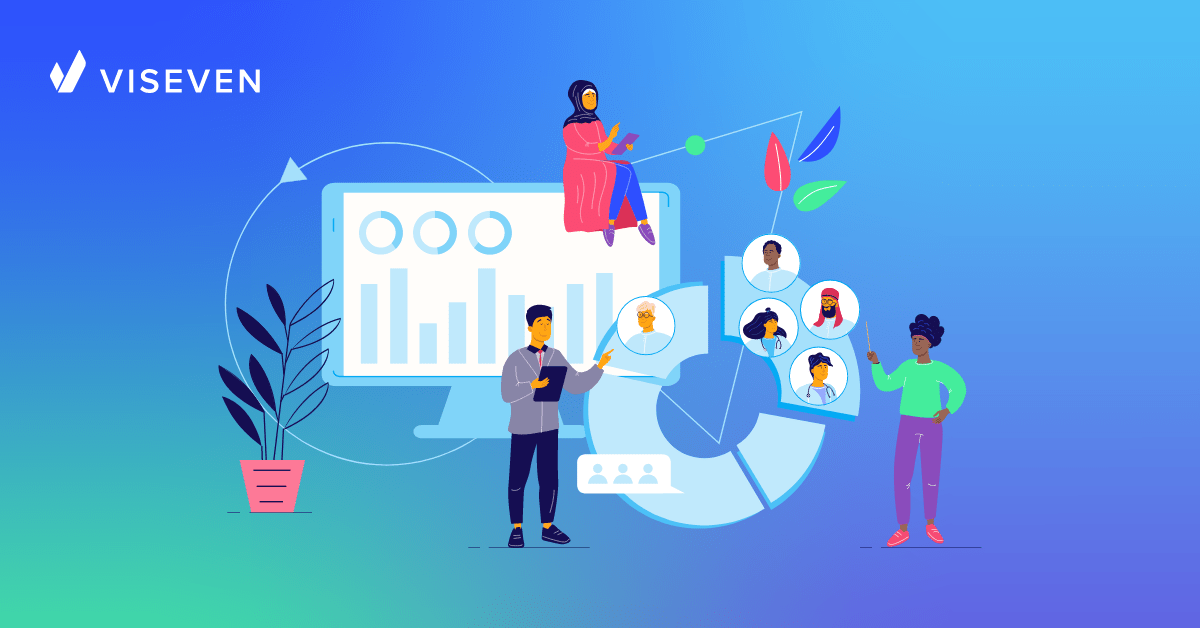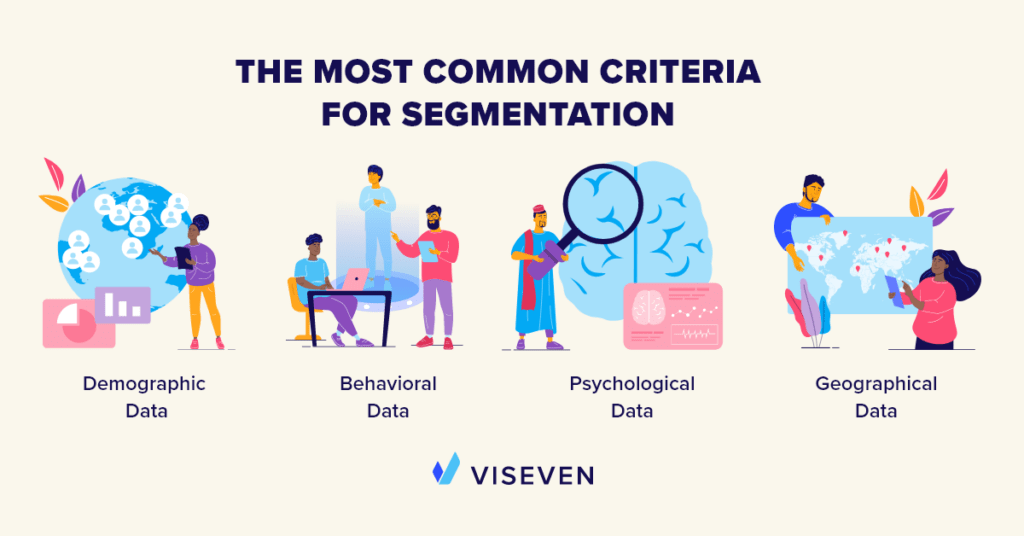Guide to Strategic HCP Segmentation

Imagine you wake up an omnichannel marketer and ask: What does omnichannel strategy implementation start with? We bet you’ll say segmentation among the mumbled words.
Any decent omnichannel strategy requires proper target audience segmentation; pharmaceutical marketing is no exception. And here’s the thing. Pharmaceutical marketing is a specific area where an omnichannel marketer cannot simply use best practices from other industries and hope they’ll work out.
In this article, you’ll discover what’s unique about healthcare professional market segmentation. We’ll stress the main advantages, review the key criteria, and analyze current and future segmentation practices.
Before getting started, let’s figure out:
What Is HCP in Marketing?
HCP’s meaning in pharma has different interpretations. HCPs stand for healthcare professionals, providers, or practitioners. HCPs can be individuals like physicians, dentists, nurses, pharmacists, or institutions like hospitals, clinics, and nursing homes. Healthcare professionals have diverse roles in the industry and engage with patients in various ways. It’s crucial to understand that not all HCPs can be your target audience, however, all HCPs are important when it comes to pharma marketing.
What Is HCP Segmentation? (And What Is Not)
HCPs segmentation refers to any practice of dividing a target audience into segments according to a set of relevant principles. On an intuitive level, all of us in marketing have that notion: you have a target audience that is a mixed crowd, but you want to be relevant and innovative to as many of them as you can. In other words, instead of offering everyone at a party a glass of wine and a steak, you want to cater to those who won’t go for that first option.
In terms of a healthcare professional audience, physicians are different too. No one can reasonably expect that an eDetailing slide or other traditional content focused on patient challenges or costs will compel everyone to consider prescribing.
If we take that analogy further, it may seem that the more segments there are, the better.
In reality, though, it is not the case.
First of all, there is content — if you have too many segments (carefully sliced up by your analysts based on a 12-dimensional matrix), each containing a handful of HCPs, there will be more of these categories than agencies available to craft all that content.
Secondly, humans are highly complex. The account you find in one segment today may appear in a different one tomorrow.
When done correctly, omnichannel approach is a powerful tool that can furnish monstrous amounts of customer data. Thus, it is crucial to remember what omnichannel audience segmentation is and is not:
- It is NOT segmenting based on anything you can think of, down to loads of tiny segments just because you can
- It IS segmenting based on the criteria relevant to your business, brand, and situation
Main Benefits of Pharma HCP Segmentation
The benefits of well-segmented campaigns are immense.
- Your tactics are more powerful, and they yield better results. With proper segmentation, you can identify more precise pharma HCP engagement moves. Based on actual needs, these moves are likely to involve HCPs. That impacts conversion even in a non-personal digital promotion channel like online ads. The conversion rate for targeted ads rises from 2.8% to 6.8% — more than twofold.
- The affinity between brand and customer increases, and it impacts loyalty. Essentially, it’s a principle similar to providing the beyond-the-pill value in pharmaceutical promotion. If life science professional feels there’s so much more to interacting with the brand than just listening to standard central messages, they’re more likely to perceive this value favorably and become loyal brand advocates.
- Quality leads. One of the best things about doing segmentation right is that once you have identified a segment, the audience within that segment that was under your radar suddenly becomes more accessible. You already have the content and methods to provide them the value they seek.
- Brand image and perception in the community. Customers form communities, and the power of reviews is enormous. That’s also true of the medical community, with key opinion leaders of different caliber swaying the fates of pharmaceutical products in entire regions. Segmenting your omnichannel campaigns will provide the life sciences professionals with targeted messaging and the reasons they personally need to refer to your brand as a trusted and valued one.
- Greater content personalization. Segmentation in Pharma allows companies to find the right audience and narrow it down only to those whose needs these businesses can meet. This strategy ensures that every service, piece of content, and even the smallest message or web banner is relatable to the consumers who encounter it. 80% of marketers consider personalization one of the biggest challenges, especially when integrating an omnichannel strategy, which makes segmentation one of the key ways to address this problem.
Common Criteria for Pharmaceutical Market Segmentation
A segmentation model or pattern is the combination of criteria you choose to segment a life sciences provider target.
In some cases, it may be location, specialty, and the number of patients. In other cases, it may be the psychological type (see below), specialty, preferred channel, and beyond.
Of course, these examples are too abstract because a more realistic combination is always focused on the brand, campaign, and many other specific factors.

Here Are the Elements of Market Segmentation:
Demographic data
-
- Age and gender
-
- Location
For B2C:
- Income
- Ethnicity
- Family status
For B2B:
- Industry
- Company size
- Position
Translating this into the HCP-pharma market, we get:
- Age and gender
- Location
- Family status
- Specialty
- Employment at HCO
- Amount of patients
- Position in the community
Behavioral data
-
- Purchasing habits
- Preferred channel of interaction
- History of interactions with the brand (frequency, proactivity, and beyond)
In healthcare provider segmentation:
- Prescribing habits (open to innovation/experiment, traditionalist, and beyond)
- Preferred channel of interaction (rep calls, email, messengers, electronic health record)
- History of previous interactions (email open-rate, and beyond)
Psychological data
-
- Personality (introvert/extravert, etc.)
- Values and priorities
- Interests
For pharma marketing and HCPs, a similar list would apply as well.
Geographical data
What Is Special About Pharmaceutical Market Segmentation?
For the most part, the segmentation components above have been developed in online campaigns, where the marketer is distant from the customer. But the pharma market lives in a different, much more individual reality with CRM and rep calls serving as a good launchpad.
Pharmaceutical segmentation makes it possible for companies to find out what they should focus their marketing efforts on. It’s not just about understanding the problem and its solution, but also identifying who might need it and when. HCPs are busy, and usually, you have a window of just a few minutes per day to reach the right audience and make them interested in what you offer. The magic of pharma market segmentation lies in its ability to pinpoint the exact HCPs who would like to hear from you.
Say you adopt more channels, each with its own metrics, and then start building a complete picture. How do you combine the two parts in your marketing strategy? It’s where it pays off to look closely at what the industry already has.

Problem of Existing HCP Pharmaceutical Practices
With the insight-collecting possibilities provided by CRM/CLM and the reps going from doctor to doctor, the market segmentation of the pharmaceutical industry would be more sophisticated for the F2F channel. However, it only seems that.
In reality, most companies stick with a simplified segmentation pattern based on their immediate commercial goals. While reps may be instructed (ultimately by the global office) to collect data in the CRM, the actual decision-making for the cycle still often relies on two criteria:
- Loyalty
- Prescription potential
The problem is that this is brand-centric, not a customer-centric model. Everything revolves around two questions: What can this account contribute to brand promotion, and is it worth it to sway their opinion?
Of course, no marketer can escape these two factors, but this only tells how hard to try to engage, not how to engage. In this situation, the representatives possess insights into each healthcare professional, their preferences and psychological traits. However, representatives don’t decide what content to generate, at least directly.
And it’s not too helpful with other channels than sales rep calls. By now, a big number of organizations use entire sets of digital channels with email segmentation often existing in a specific universe. Meanwhile, a smarter take on rep-collected metrics involves psychology.
Psychographic Market Segmentation
Nothing can be more beneficial in crafting high-ROI targeted campaigns than knowledge about the target audience’s psychology. In B2C and FMCG where omnichannel practices first emerged, things are less complicated than in pharma HCP marketing. Regulations don’t overshadow customers’ choices while making prescriptions requires a hefty dose of scientific evidence.
However, as noted above, experienced and high-performing reps still use psychology in communications during their calls, if only to establish that famed personal connection with the provider.
When you want to expand to multichannel and then omnichannel approach, the last thing you want to lose is that connection. Besides, being aware of what moves this or that segment of physicians to favor the product over others helps create innovative content that performs.
That’s why companies are starting to include psychological data into their segmentation models, providing a further dimension. Some CRM systems have fields configured for this data. Currently, not many marketers use them in commercial operations planning, though.

The trick here is to define what psychological traits will be helpful outside the CRM and in the global world of omnichannel HCP engagement. That which lies on the surface — introversion/extraversion, Myers-Briggs types, empathy scales — is not very helpful per se. That is until you find combinations that serve to determine common psychological types.
For example, you may notice that the more pragmatic, cost-aware physicians are also patient-centric in their values. They’re generally more open to communications with pharmaceuticals regardless of their introversion/extraversion score.
Such psychological typing helps develop and generate fragments for rep-triggered email campaigns that reps could combine before sending to HCPs. The same logic can be extended to HCP targeting strategies that include other digital channels. These channels influence healthcare professionals’ choices (and the choice of key messages) and behavior when building omnichannel customer journeys.
Emerging Data Layers and Discrepancies
As pharmaceuticals are embracing ever more channels, management boards come across targeting principles and models that are traditional to those channels.
Take email (mass mailing, not the rep-triggered email). This channel comes with a targeting pattern that includes browser/device use and even habits when the customers open the emails (impacting sending time). The web has targeting practices too involving geolocation and other things tracked with click maps and SEO-related research.
Do these models have life in pharmaceuticals? No doubt. Do they have value outside the channels they were developed for? Sometimes. What is the issue to solve? Few people take time to put these multiple models together and filter out what criteria are relevant everywhere, regardless of the channel. Instead of a brand-centric segmentation pattern we covered earlier, multichannel brings about a channel-centric one.
This needs to be broken, and this break is part of the transition to the omnichannel experience. Integrating data from different channel-specific platforms is the tech side of the question and is already being implemented at many companies across the market. The next stage is a shift towards a truly customer-centric mindset.
New HCP Targeting Practices in Omnichannel Marketing
What is the future of HCP targeting and segmentation? What practices are sustainable in an omnichannel model? Various organizations are working on their models, tactics, and methods, but here are some common findings that our expertise at Viseven confirms.
Implementation Process
Thankfully, there is no need to start from scratch. A good practice is to build upon what your business has aggregated throughout the years: the customer base, CRM data, pharma HCP insights identified by reps, email metrics, and questionnaires.
As you add more channels, find out whether the targeting segmentation that seems evident contributes to the overall ROI of the omnichannel campaign, not its channel-bound part.
Another essential thing to remember is that segmentation is an ongoing process rather than a once-and-for-all initial step. Omnichannel approach starts with a segmentation process not chronologically but logically. You harvest additional data in the course of an omnichannel campaign.
In a recent study, we described a case when the HCPs’ reaction to an automated email resulted in them either moving to the next step, the management changing the key message, or changing the channel to a messenger. It is natural to use the data on a message or channel preferences obtained in this way to segment the audience further along the way, refining the approach.
Common Mistake
We have briefly alluded to it when talking about the approximation analogy. It’s crucial not to make segmentation a goal in itself — refining here is not about creating an array of categories that multiply to produce a host of additional small segments of a target.
It’s the message that matters. One should start thinking about the message (or messages) they want to convey. It’s in connection with the messages you want to get through that you can define what insights are relevant for segmentation solutions.
Integrate at Every Step
Finally, the most important point is that there should be one governing segmentation pattern above any channel, even above the CRM. That’s what makes the omnichannel approach different from extended multichannel solutions. It’s all about HCPs with their needs and the value your brand brings, not the possibilities of a single channel, however efficient.
It requires a common data pool across channels and integration of the corresponding platforms that underlies it. With a robust, integrated omnichannel architecture, you can not only put together the data from CRM, email, web, or social, but make decisions based on the extended picture of customers you have.
Currently, only 15% of pharmaceutical companies believe their approach to HCP engagement is omnichannel. This figure is expected to change in the coming years. However, many pharmaceutical organizations continue to grapple with numerous challenges that make their transition to omnichannel marketing impossible, including budget constraints and limited resources.
With experience in setting up omnichannel architectures and campaigns based on the customer’s existing infrastructure and behavior, our experts know how to make your current technical and data capacities work to their maximum. Our team will create a new successful omnichannel mindset which you can then extend and scale.
If you want to get more practical and actionable information, professional advice, and technical expertise on building a segmentable and segmented omnichannel strategy, contact our experts or fill the form below. We’ll get back to you shortly!



